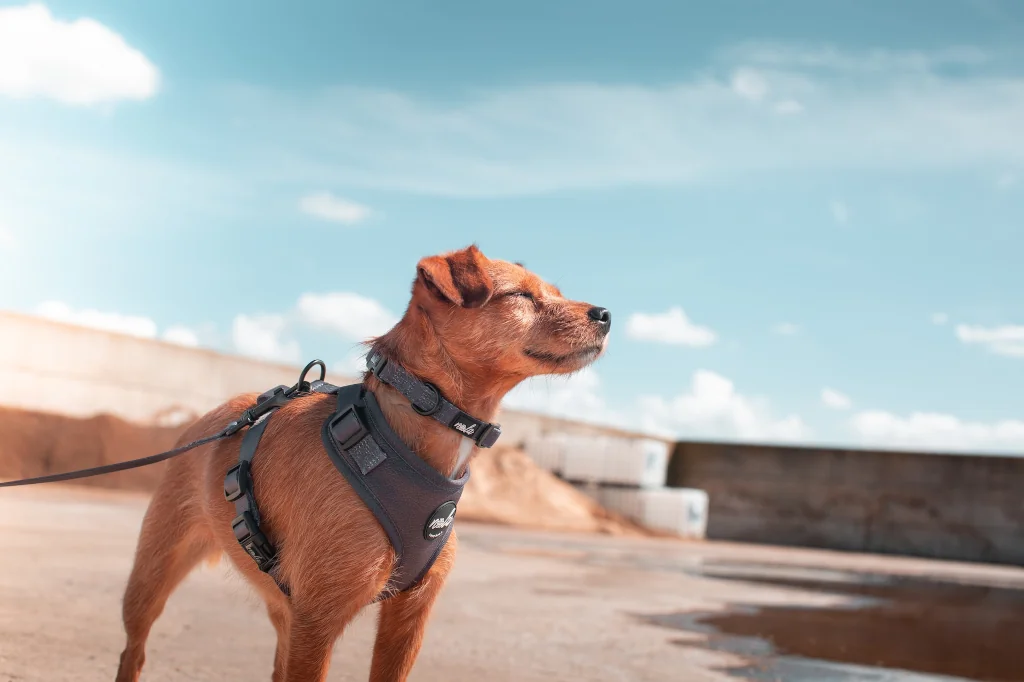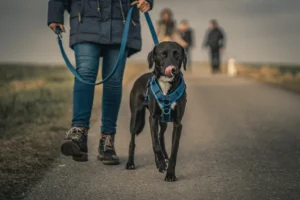Disclosure: We may earn a commission from helpful, relevant links in our content. No cost to you. See our privacy policy.
Welcome, dog lover!
If you’ve ever returned home from a walk with your furry friend feeling like you’ve just been put through a vigorous weight-pulling competition, we get you.
The simple joy of a leisurely stroll can quickly become a struggle with a leash-pulling pup in tow. Imagine, instead, a walk where your arm doesn’t feel like it’s being yanked out of its socket, and you’re not constantly wrestling your dog back to your side.
That’s the kind of walk we’re here to help you achieve with these training aids to help you with leash pulling. Stick with us and we’ll transform those tiring tug-of-war episodes into enjoyable, stress-free walks.

Why Do Dogs Pull on the Leash?
Dogs pull on the leash for various reasons. Foremost, they’re naturally faster walkers than we are, and their curiosity about the world around them often outruns our leisurely pace.
It’s a big, fascinating world out there, and your furry friend is just excited to sniff it all out!
Sometimes, dogs may also pull if they’re not properly socialized or are anxious in new environments. It’s not a sign of a “bad” dog, but rather a behavior that can be understood and reshaped with time, patience, and the right training approach.
Remember, it’s about communication and understanding – and we’re here to guide you through that and offer you some of the most effective tools to help when your dog pulls on the leash.
Best Training Aids to Stop a Dog From Pulling
Walking your dog should be a joy, not a chore. If your furry friend is always tugging on the leash, it can make your peaceful walk into a stressful tug-of-war. Luckily, there are excellent training aids out there designed to help control pulling, which I’ve personally tested with my own dogs, Sam and Charlie. Here’s the rundown:
Front-Clip Harness: A Miracle Worker
A front-clip harness is my top recommendation to help manage a pulling dog. Why? When your dog pulls, the front-clip harness guides them back towards you, naturally discouraging the pulling behavior. It offers better control without causing any discomfort to your dog, unlike some traditional collars.

I personally love and recommend the PetSafe Easy Walk No-Pull Harness. It’s durable, comfortable, and easy to use, with a variety of sizes for a perfect fit.
Two years ago, while taking Charlie, my younger and untrained Golden Retriever, out for his daily walk, we stumbled upon a family having a picnic in the park. The scent of their sandwiches immediately sent Charlie lunging towards them in all his over-excited glory. I think I’ve never seen him so excited, must have been some great sandwiches…
Anyway, thanks to the front-clip harness, I managed to gently guide him back to my side, leaving the family to enjoy their lunch undisturbed. That’s when I truly appreciated the effectiveness of this front-clip harness, and I’ve been using it to this day.
Training Leash: The Perfect Length Matters
A training leash, particularly a shorter one, can be especially effective. It gives you more control and prevents your dog from straying too far from you. With a shorter leash, your dog remains close, helping to establish a side-by-side walking routine.
For the initial stages of training, I suggest a sturdy, 6-foot leash. This gives your dog some freedom to explore, but not too much that they are beyond your control.

The Leashboss Original – Heavy Duty Double Handle stands out with its durability and dual handles, making it ideal for training purposes. I used this leash a while ago for Sam, my well-trained German Shepherd, and he took to it beautifully, learning quickly that straying too far was no longer an option.
Head Collars: Immediate Control
Head collars, or halters, can provide immediate control by guiding your dog’s head, similar to how a halter is used on a horse. They can be extremely effective for larger, stronger breeds that might be hard to control otherwise.

One of the best in the market is the Gentle Leader Headcollar. It offers great control, especially for larger breeds, but it’s gentle and doesn’t cause discomfort.
However, remember that using a head collar is a temporary measure and not a long-term solution. We’re looking for a behavioral change in our pups, after all, not just a quick fix.
Clickers and Treats: Positive Reinforcement
Finally, remember that dogs respond best to positive reinforcement. A clicker paired with treats can be a wonderful training aid for leash pulling. The idea is to click and reward your dog when they’re walking by your side without pulling.
Over time, they’ll associate the positive experience (treats!) with the desired behavior (no pulling).
I highly recommend the EcoCity Dog Training Clicker with Wrist Strap. Paired with your dog’s favorite treats, this clicker has proven highly effective in positive reinforcement training.

In no time, both Sam and Charlie started responding enthusiastically to this training method, their tails wagging in anticipation of the ‘click’ and treat.
Here’s a summary table of all the suggested training aids for leash pulling:
| Training Aid | Why It’s Good for Leash Pulling | Recommended Product |
|---|---|---|
| Front-Clip Harness | Redirects pullers; promotes controlled walking | PetSafe Easy Walk |
| Training Leash | Ensures closeness; fosters side-by-side walk | Leashboss Original Heavy Duty Two Handle |
| Head Collar | Guides head; ideal for strong breeds | Gentle Leader Headcollar |
| Clicker | Boosts positive reinforcement; curbs pulling | EcoCity Clicker with Wrist Strap |
As with all training aids, the key is to use them correctly and consistently. Patience and persistence, coupled with the right tools, can turn your walk-time woes into peaceful promenades.
Tips on How to Use Leash-Pulling Aids
Let’s dive into how to effectively use these leash-pulling aids for optimal results:
- Fit is King. Whether it’s a front-clip harness, a head collar, or a training leash, the right fit is crucial. A harness or collar that’s too tight can be uncomfortable and restrictive, while one that’s too loose can pose a risk of your dog slipping out of it. Spend time to find the perfect fit and make any necessary adjustments.
- Train Before You Walk. Before you hit the streets, spend some time at home familiarizing your dog with their new training aid. This will help make your walks less stressful, as your dog would already have gotten used to the feel of the aid.
- Consistency is Key. Whichever aid you decide to use, remember to use it consistently, preferably every day. Training aids aren’t magic wands; they require consistent use to truly impact behavior.
- Be Patient. Dogs don’t change their habits overnight. Remember to be patient and keep your expectations realistic.
Now here’s something unique. Most guides might miss this:
- Rotation Strategy. If your dog gets comfortable with one aid and continues to pull, try rotating aids. Switch between a harness and head collar, or try different types of leashes. This can keep your dog guessing and make them more responsive.
How to Train a Dog Against Leash Pulling?
Now that you’re equipped with the right training aids and the tips to use them, let’s look at how to actually train your dog against leash pulling.
The first thing you should try, is to teach the ‘Heel’ Command. Training your dog to heel, or stay by your side, is a fundamental step in curbing leash pulling. Start indoors with minimal distractions, and gradually progress to more challenging environments.
When your dog starts pulling, simply stop and stand still. This method, often referred to as “be a tree,” sends a clear message to your dog that pulling gets them nowhere.
Whenever your dog is walking beside you without pulling, reward them with treats and praise. Over time, they’ll associate good behavior with positive rewards. This is called ‘positive reinforcement.’
If your dog pulls, turn around and walk in the opposite direction. This ‘penalty yards’ method sends a clear message that pulling leads to less, not more, exploration. If leash pulling persists despite your best efforts, don’t hesitate to seek help from a professional dog trainer. They can provide personalized guidance based on your dog’s specific needs.
I have to link to this video once more, because sometimes aids are not enough. You have to take the time to show your dog what’s good and what’s bad, and this video does that:
Remember, training a dog against leash pulling requires patience, consistency, and a lot of love. Each dog is a bit different, so try a few different things until you find what is most effective for your dog. Once you find that, stick with it.
How to Deal With Reactive Dogs on the Leash?
Leash reactivity, where your dog lunges, barks, or becomes overly excited at the sight of other dogs or stimuli, can make walks challenging. Here’s how you can manage and train a reactive dog:
- Understand Your Dog. First, it’s important to recognize your dog’s triggers. Is it other dogs, people, cars, or loud noises? Understanding this helps in formulating an effective training strategy.
- Create Distance. When you see a potential trigger approaching, create distance between your dog and the trigger. This might mean crossing the street or stepping off the trail.
- Use ‘Look at That’ (LAT) Technique. LAT technique involves rewarding your dog for looking at their trigger and then looking back at you. This helps your dog associate the sight of their trigger with positive experiences.
- Try Counter-Conditioning. Counter-conditioning involves changing your dog’s emotional response to their triggers. For instance, offer treats and praise when they see their trigger to associate it with positive things.
Now for a less common, but effective strategy:
- Master the U-Turn. If your dog becomes too aroused, master the art of making a swift, smooth U-turn and walking away from the trigger. This can become an invaluable tool in managing your dog’s reactivity.
FAQs
What is the most effective leash-pulling tool?
The most effective leash-pulling tool depends on the individual dog, but a front-clip harness is often highly effective. It naturally discourages pulling by guiding the dog back towards the handler.
What is the best collar and lead to stop a dog from pulling?
A front-clip harness, combined with a sturdy 6-foot leash, is generally an excellent option to deter dogs from pulling on their leash. Follow our guides to choose the right harness, or to find the right leash for your dog.
Are there breeds that are harder to train for leash pulling?
Breeds known for their strength and energy, like Huskies or Boxers, might present more challenges with leash pulling. However, with the right training strategies, any breed can learn to walk nicely on a leash. Consider teaching your dog loose leash walking.
How do you fix leash anxiety?
Fixing leash anxiety involves gradual desensitization and positive reinforcement. Start by letting your dog wear the leash around the house, rewarding them for calm behavior. Gradually introduce short walks, continuing to reward calm behavior, and slowly increasing the walk duration over time.
Alex, a passionate animal lover, has experience in training and understanding animal behavior. As a proud pet parent to two dogs and three cats, he founded AnimalReport.net to share insights from animal experts and expand his knowledge of the animal kingdom.




